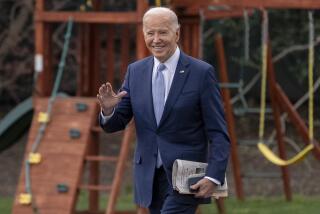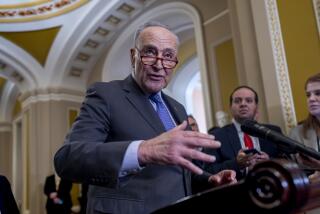Government shutdown may crimp holiday shopping
Add another potential casualty of Washington’s gridlock: the holiday shopping season.
The congressional stalemate that brought about a partial government shutdown has rattled Americans already spooked by years of economic weakness. And the uncertainty could stretch into 2014, with debate continuing over the federal budget and debt limit.
The shaky consumer confidence is pummeling sales forecasts for the holiday season, a crucial period that can account for up to 40% of a retailer’s annual revenue.
The National Retail Federation, the industry’s top trade group, said Wednesday that shoppers this year planned to reduce spending on presents and holiday preparations.
More than half of consumers surveyed blame the economy for denting their holiday budgets. And nearly 3 in 10 fault the political bickering on Capitol Hill for cutting into their merrymaking plans.
The average consumer will spend $737.95 on gifts, decor and greeting cards, 2% less than the $752.24 shelled out last year. Of more than 6,000 survey respondents, nearly 80% said they intended to spend less overall during the season.
The value of gifts for family members is projected to slide 2% from last year. Earlier this month, the federation had projected that holiday sales would hit $602.1 billion.
Also Wednesday, the Standard & Poor’s credit rating agency sketched a bleak picture in a report.
“If people are afraid that the government policy brinkmanship will resurface again, and with it the risk of another shutdown or worse, they’ll remain afraid to open up their checkbooks,” Standard & Poor’s researchers wrote. “That points to another humbug holiday season.”
Retail sales were lagging far before the government shutdown.
In September, during the prime back-to-school season, sales at stores open at least a year grew modestly but missed Wall Street’s expectations. Analysts blamed volatile weather, middling wage growth and uninspiring fashions on top of the looming threats of closing government agencies and defaulting on the national debt.
Retail growth has been weak all year. Many stores spent last month trying to purge aisles of piles of stock from the summer.
The slow performance isn’t surprising, considering the backdrop of the national economy, which expanded at a “modest to moderate pace” in September and early October, according to the Federal Reserve’s “beige book” report Wednesday.
The report, so named for the color of its cover, showed that employment growth remained muted, with many businesses “cautious to expand payrolls, citing uncertainty surrounding the implementation of the Affordable Care Act and fiscal policy more generally.”
Consumers boosted spending on technology and big-ticket items such as autos and home goods, driven by pent-up demand and attractive financing deals. But overall, retail sales “were a bit soft,” according to the report.
Small retailers haven’t been faring well, according to research firm Sageworks. This year, revenue at mom-and-pop retailers with less than $5 million in annual sales has shrunk nearly 2% after three years of growth, Sageworks said.
Marshal Cohen, an analyst with NPD Group, said he expected the coming holiday season to “be a tricky one for retailers.”
“With fewer days between Thanksgiving and Christmas, government distractions and lack of newness in the marketplace, retailers will have to rely more on promotions to excite the consumer,” he said.
This week, the International Council of Shopping Centers said the shutdown had already forced 40% of consumers it surveyed to limit their spending.
Of those, the majority said the size of their scale-back had been minimal. But about a third called the drop “considerable.”
The survey of a nationally representative sample of more than 1,000 adults found that nearly half of those with less than $35,000 in annual income were being more frugal, compared with nearly a third of respondents earning more than $100,000.
“It is clear that the fallout of the past two-week impasse in Congress has affected consumers’ willingness and maybe their ability to spend,” said Michael Niemira, vice president of research for the shopping centers group.
A report last week from Accenture was more optimistic about holiday shopping, predicting an 11% increase in per-person spending compared with 2012. But of the 500 respondents, 94% said discounts would be key to their purchasing decisions, up from last year.
In a public letter to Congress on Oct. 9, National Retail Federation Chief Executive Matthew Shay said the government shutdown had had far-reaching consequences for retailers, adding that “only the collapse of Lehman Brothers … has done more damage to consumer confidence in such a short period of time.”
Shay also complained that the monthly employment numbers provided by the government and used by retailers as a gauge of economic health weren’t available. Neither are federal retail sales figures.
Retailers, which expected to bring more than 700,000 seasonal workers on board, have been unable to use the E-Verify system to determine immigration and citizenship status for new hires, Shay said.
And many of the government workers responsible for clearing imported cargo — 4 million containers so far — have been furloughed, threatening retailers’ ability to stock shelves with holiday merchandise made abroad.
“Even if Customs and other agencies can get that merchandise off the docks without a hitch, shutdown-fueled consumer worries over the economy could leave that merchandise sitting on shelves well past Christmas,” Shay wrote. “These and other problems come at the worst possible time for the retail industry.”
Twitter: @tiffhsulatimes
More to Read
Inside the business of entertainment
The Wide Shot brings you news, analysis and insights on everything from streaming wars to production — and what it all means for the future.
You may occasionally receive promotional content from the Los Angeles Times.











